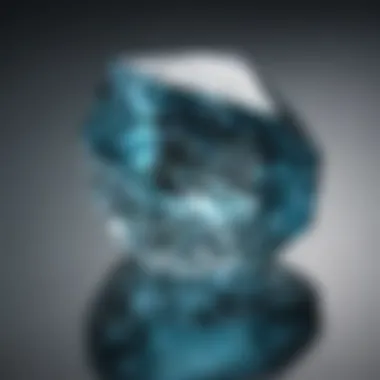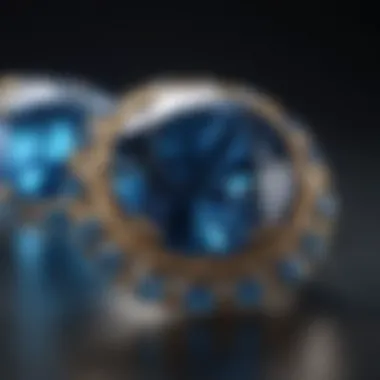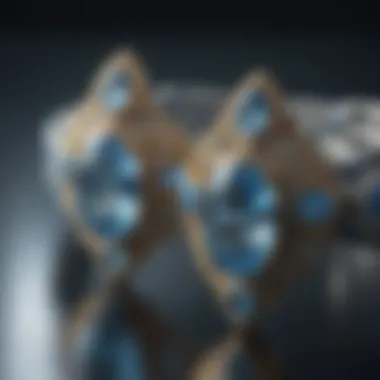Aquamarine, Blue Topaz, and Sapphire: A Gemstone Comparison


Intro
In the vast realm of gemstones, aquamarine, blue topaz, and sapphire stand out not just for their stunning hues, but also for their rich history and significance. Each of these stones offers not only beauty but also a fascinating narrative woven through ages, cultures, and traditions. This article aims to delve deeply into these captivating gems, providing insights into their origins, properties, and roles in the world of jewelry and healing practices.
As we embark on this journey, gemstone enthusiasts, collectors, and design aficionados will gain a better understanding of what makes each of these stones unique. Whether you're new to gemstones or a seasoned collector, the richness found in aquamarine, blue topaz, and sapphire will inspire and inform your choices. Let's navigate the intricate waters of gemstone attributes and cultural importance, ensuring you are well-equipped for any gemstone-related endeavor.
Preface to Gemstones
Gemstones have always held a certain allure for humanity, acting as symbols of beauty, wealth, and even power. From ancient civilizations to modern societies, they continued to charm people with their vibrant colors and unique stories. Understanding gemstones is crucial, especially if one intends to buy, collect, or design with them. In this article, we delve into the fascinating world of aquamarine, blue topaz, and sapphire, three of the finest jewels that offer rich narratives. Each stone has its own characteristics and value, making it vital for enthusiasts and collectors to comprehend these distinctions.
Overview of Gemstone Classification
When talking about gemstones, the classification plays a significant role. Generally, gemstones are divided into two categories: precious and semi-precious. The former includes diamonds, rubies, sapphires, and emeralds—typically the market darlings due to their desirability and rarity. The latter category encompasses a broader array, including stones like amethyst, turquoise, and, of course, aquamarine and blue topaz.
However, this classification isn’t just about market value. It also relates to the stone's durability, color, clarity, and overall visual appeal. For instance, sapphires come in various colors, while aquamarine is mostly recognized for its stunning blue-green hues.
Understanding gemstone classifications helps buyers and collectors identify what they truly desire and value in a gem, paving the way for informed decisions.
Importance of Color and Clarity
Color and clarity are two pivotal aspects when it comes to evaluating gemstones. The color of a gem is perhaps its most striking feature. For aquamarine, its soft blue exudes calmness, while blue topaz can range from pale to deep blue, with its clarity enhancing the brightness. Sapphire is often celebrated for its bold colors but can also appear in various shades, each with its own significance and appeal.
Clarity likewise plays a monumental role in determining a gem's value. Look closely and you will see that gems can host internal features known as inclusions; these can either detract from or enhance a gem's value. Generally, the clearer the gemstone, the more valuable it becomes. Thus, examining these traits is crucial whether you are an aficionado or a casual observer.
In all, grasping the foundations of gemstone classification and understanding the impact of color and clarity equips you with the knowledge you need to navigate the intricate world of gemstones.
Aquamarine: A Closer Look
Aquamarine, with its serene blue hues, is often associated with tranquility and clarity of thought. This section dives deeper into its fascinating features, market presence, and practical applications. Understanding aquamarine not only enhances one’s appreciation for it but also serves as a vital step in making informed choices when purchasing or designing jewelry. Its allure lies in both its striking visual appeal and its rich historical context, making it a favorite among collectors and designers alike.
Characteristics and Formation
Aquamarine is a member of the beryl family, alongside other notable gemstones like emerald and morganite. Formed under high pressure and temperature conditions within the earth's crust, it typically crystallizes in hexagonal shapes. Its chemical composition is primarily aluminum beryllium silicate. The birth of this gemstone is intriguing, as it forms through the slow crystallization of magma or through the alteration of other minerals in conditions rich in water. This formation process contributes to its relatively clear and flawless appearance, gifted with a glassy luster that makes it stand out in a jewelry collection.
Color Variations and Value Factors
The colors of aquamarine can span from a pale blue to a deep blue-green, often dictated by the presence of iron. Of course, the more vivid and intense the hue, the higher the value. Factors influencing the gemstone’s worth include clarity, size, and cut. While lighter shades are also sought after, it’s the darker, more saturated pieces that catch the eye of collectors. Moreover, the stone’s clarity is crucial; inclusions can significantly decrease value. Thus, when purchasing aquamarine, one must weigh the shades with clarity to determine its quality and ultimately, its price.
Historical Significance and Lore
Aquamarine has been celebrated throughout history, often believed to embody properties of the sea. The ancient Romans viewed it as a stone of sailors, ensuring safe passage over turbulent waters. Moreover, it has been associated with the goddess Venus, making it a talisman for love and protection. Legends say that aquamarine can calm the tempestuous nature of emotions, thus encouraging serenity and peace. This historical significance envelops the gemstone with a rich tapestry of mythology, elevating its allure beyond just physical beauty.
Uses in Jewelry Design
In contemporary jewelry design, aquamarine flourishes as a versatile stone, whether set in delicate rings, elegant necklaces, or striking earrings. Its calming color complements various metals, from white gold to rose gold, making it a go-to for both casual and formal pieces. Designers often use aquamarine in combination with other gemstones, creating breathtaking arrangements that speak to elegance and sophistication. It also suits custom designs, perfect for creating unique pieces that can celebrate special occasions like anniversaries or birthdays.
Care and Maintenance Tips
Maintaining the beauty of aquamarine requires a little diligence. Though it ranks a solid 7.5-8 on the Mohs scale, indicating decent hardness, it isn’t completely invulnerable to scratches or chips. Here are some care tips:
- Regular Cleaning: Use a gentle soap solution and a soft brush to clean.
- Avoid Harsh Chemicals: Detergents, ammonia, or strong solvents can dull the surface.
- Store Properly: Keep it in a separate compartment to avoid scratches from other jewelry.
Following these guidelines will help ensure that your aquamarine remains as stunning as the day you bought it.


Blue Topaz: An Exploration
Blue Topaz is one of those gemstones that captures attention not just for its stunning hues but for its myriad meanings and uses throughout history. Its vibrant colors range from pale sky blue to the rich, deep tones reminiscent of a clear ocean. This section dives into the properties, market dynamics, cultural significance, design applications, and care practices surrounding this cherished stone.
Properties and Gemological Features
Blue Topaz is a silicate mineral that primarily derives its color from the presence of iron and radiation exposure during its formation. With a hardness of 8 on the Mohs scale, it boasts significant durability, making it suitable for jewelry that endures daily wear. The transparency of Blue Topaz is striking, often categorized by its clarity and brilliance.
Among gemstone enthusiasts, the distinction between naturally colored blue topaz versus treated varieties is essential, as the latter might involve irradiation to enhance color. Understanding the gemological features can guide buyers in making informed choices, ensuring they appreciate what they are getting.
Market Value and Pricing Influencers
The market for Blue Topaz has evolved, influenced by various factors. Firstly, the gemstone's availability plays a key role; while Blue Topaz is often mined in places like Brazil and Nigeria, quality stones in vibrant color may be less common. Additionally, the saturation of blue affects price, with deeper hues typically commanding a premium.
"Prices can soar dramatically if the gemstone exhibits exceptional clarity and a vivid saturation that captures the eye."
Another vital aspect is the presence of flaws—known in the industry as inclusions—which can reduce the value of the stone. As buyers become more savvy, they often look for certification from reputable gemological laboratories, which can assure them of quality and authenticity.
Cultural Symbolism and Beliefs
Throughout history, Blue Topaz has held significant cultural implications. In some contexts, it symbolizes truth and forgiveness, believed to enhance intelligence and creativity. Ancient Egyptians prized this stone, creating jewelry and artifacts from it, associating it with the sun. Even in modern times, it is said that wearing Blue Topaz strengthens communication, making it a popular choice among speakers and performers.
From a birthstone perspective, Blue Topaz is the birthstone for November, promoting a sense of calm and peace. This duality makes it a versatile option for personal adornment and gifting.
Design Applications in Jewelry
When it comes to design, Blue Topaz offers a captivating palette for various types of jewelry. Its vibrancy lends itself well to earrings, necklaces, and rings. The gem pairs beautifully with different metals like white gold, making the blue pop. Artistic settings often enhance its light reflection, creating an almost ethereal sparkle.
Designers frequently experiment with different cuts, such as round, oval, and pear. Each cut can bring out unique facets of the stone's color and clarity.
Popular Jewelry Types Featuring Blue Topaz
- Engagement Rings: A unique and bold choice for those looking for something beyond the traditional diamond.
- Statement Rings: Large Blue Topaz stones can serve as conversation starters in any setting.
- Charm Bracelets: Adding a touch of color while representing personal stories.
Best Practices for Cleaning and Care
To maintain the beauty and longevity of Blue Topaz jewelry, proper care is crucial. Here are some tips:
- Regular Cleaning: Use warm soapy water and a soft brush to remove dirt. Avoid harsh chemicals that can damage the stone.
- Storage: Store each piece separately to prevent scratching.
- Avoid Extreme Conditions: Steer clear of exposing the gemstones to intense heat or sudden temperature changes, which could cause cracking.
By following these guidelines, owners can ensure their Blue Topaz remains as dazzling as the day it was acquired.
Sapphire: The Timeless Gem
Sapphire holds a devoted place in the world of gemstones, often regarded as a symbol of nobility, truth, and faithfulness. Its stunning hues and remarkable durability make it a sought-after stone not only for its beauty but also for its rich history and cultural significance. In this section, we will delve into the diverse characteristics of sapphire, its varied colors, the elements that influence its quality and value, and its vast cultural heritage, as well as its modern-day applications in jewelry design. Providing insights into safekeeping and maintenance will round out our comprehensive look at this timeless gem.
Diverse Colors and Their Meanings
Sapphire is commonly associated with a deep royal blue, but it is much more versatile than that. The stone can be found in an array of colors, including:
- Blue: Represents wisdom and nobility.
- Pink: Symbolizes compassion and tenderness.
- Yellow: Associated with prosperity and joy.
- Green: Signifies harmony and peace.
- White: Often linked to purity and innocence.
The fascinating spectrum of colors speaks to its broad appeal across cultures. For instance, in Eastern traditions, sapphires are often linked with spiritual enlightenment. The meanings attached to these colors not only enhance their aesthetic value but also provide emotional and symbolic dimensions that resonate with gemstone enthusiasts and collectors.


Factors Affecting Quality and Value
When it comes to determining the quality of a sapphire, several key factors must be considered:
- Color: The more vibrant and vivid the hue, the higher the value. A pure, rich blue sapphire is often the most sought-after.
- Clarity: Minimal inclusions lead to greater clarity and thus enhance value.
- Cut: Skillfully cut sapphires showcase their brilliance and beauty, impacting their market appeal.
- Carat weight: Larger stones are naturally rarer and typically command higher prices.
Collectors should keep these factors in mind when evaluating sapphires. A well-chosen piece not only serves as a decorative element but can also represent a sound investment.
Cultural Importance Throughout History
Sapphire's importance spans centuries and cultures. In ancient India, it was believed that wearing a sapphire would bring divine protection and was often linked to royalty. The stone has adorned crowns and royal jewelry across the globe, from European monarchies to Asian dynasties.
In the Middle Ages, clergy often wore sapphire as a symbol of heaven, and it was widely considered a protective talisman for travelers. The belief in its metaphysical properties continues today, where sapphire is thought to promote mental clarity and emotional balance.
Usage in Contemporary Jewelry
Today's jewelry designers utilize sapphire in innovative ways, integrating it into various styles, from classic to modern contemporary designs. Sapphires can be found in engagement rings, earrings, pendants, and bracelets. The versatility of this gemstone allows for imaginative settings and pairings with diamonds, white gold, or even different colored gemstones.
"Sapphire's wide array of colors and durability makes it a preferred choice for everyday wear and special occasions alike."
Guidelines for Safekeeping and Maintenance
To maintain the beauty and longevity of sapphires, proper care is essential. Here are some best practices:
- Cleaning: Use mild soap and warm water, avoiding harsh chemicals.
- Storage: Keep sapphires in a soft cloth or dedicated jewelry box to prevent scratches.
- Avoiding Impact: While sapphires are durable, it’s wise to avoid wearing them during heavy physical activities to minimize the risk of damage.
In summary, sapphires represent not just a visual allure but a tapestry of history and cultural significance. Understanding the diverse colors, quality determinants, and cultural context enriches one's appreciation for this exquisite gemstone.
Comparative Analysis of Aquamarine, Blue Topaz, and Sapphire
When it comes to a detailed examination of aquamarine, blue topaz, and sapphire, the comparative analysis of these three gemstones doesn’t just scratch the surface of their physical beauty. It digs deep into the backgrounds, uses, and value propositions each stone holds. This discussion not only helps enthusiasts and collectors understand the unique characteristics of aquamarine, blue topaz, and sapphire but also allows potential buyers to make informed decisions informed.
Comparing gemstones opens a window into how these colorful wonders interact with human emotions, cultural significance, and even market dynamics. It’s more than just a visual distinction; it’s about understanding what each stone signifies. The nuances found in their colors, their durability, and intrinsic value all play crucial roles in their appeal.
Color Preferences and Associations
Color can evoke feelings and impressions well beyond mere aesthetics. Each of these gemstones brings a distinct palette that resonates differently with people. Aquamarine, with its tranquil sea-blue hues, often draws comparisons to calm and clearness, reminding one of crystal-clear waters.
On the other hand, blue topaz, which can vary from a deep sky-blue to a lighter shade, carries associations of wisdom and communication. Many believe that this gemstone aids in fostering honest dialogue.
When we move to sapphire, the rich, royal shades of blue make it a popular choice for lovers of luxury and elegance. Yet, sapphires also come in a spectrum of colors, each carrying its own significance. Notably, the deep blue sapphire is often linked to nobility and truth.
In terms of consumer preferences, you might find that:
- Aquamarine appeals to those looking for a calm, soothing presence.
- Blue Topaz is popular among those wanting to express hope and honest communication.
- Sapphire tends to attract individuals seeking a touch of grandeur and classic sophistication.
Durability and Suitability for Everyday Wear
One angle of comparison centers on durability. For daily wear, durability is paramount. Aquamarine ranks at a 7.5 to 8 on the Mohs scale of hardness, making it fairly resistant to scratches and suitable for most jewelry settings.
In contrast, blue topaz boasts a hardness of 8, giving it a slight edge in terms of resilience. This makes blue topaz ideal for statement pieces that can endure everyday wear without much risk of damage.
Sapphire, being one of the hardest gemstones with a score of 9 on the Mohs scale, stands out as an excellent candidate for both engagement rings and everyday jewelry, marking it as a steadfast companion. Its strength not only protects the stone but also symbolizes enduring love.


Investment Potential and Market Trends
The market for these gemstones is as varied as their characteristics. Sapphire frequently dominates discussions around investment potential, with certain stones, like those from Kashmir, fetching astronomical prices at auctions. The rarity and unique color saturation hike up their market value considerably.
Conversely, aquamarine, while stunning, isn’t always viewed as a long-term investment. Its market value can fluctuate and is typically lower than that of sapphire but higher than that of common blue topaz. The demand remains steady, particularly for high-quality specimens with deep color saturation.
Blue topaz, despite being more abundant, holds its place in the market by being economically accessible for buyers seeking beautiful yet affordable gemstones. It is mostly sought for fashion or statement pieces rather than as an investment-grade stone.
Purchasing Considerations
When diving into the world of gemstones, especially with aquamarine, blue topaz, and sapphire, understanding purchasing considerations is paramount. These elements not only enhance the buyer's confidence but also ensure that the investment made is worthwhile. Amidst the sparkle and allure of these stones lies the risk of fraud and overpricing. Hence, assessing various factors becomes crucial in making a well-informed purchasing decision.
Identifying Genuine Stones
Determining the authenticity of gemstones is like trying to find a needle in a haystack. The market is flooded with treatments and imitations. So, how does one spot a genuine aquamarine, blue topaz, or sapphire? Here are a few red flags to consider:
- Visual Examination: Genuine stones usually have minor inclusions. A perfect stone could signal a fake or a highly treated stone.
- Color Consistency: Authentic gemstones tend to have slightly varying colors within the stone itself. If the color looks too uniform, that’s something to keep an eye on.
- Weight: Real gemstones are heavier than their synthetic counterparts. Weighing a stone can give some insight into its authenticity.
Using tools such as a loupe or UV light can further enhance your ability to spot real from fake. It pays to be skeptical, especially when prices seem too good to be true.
Understanding Certification and Grading
Certification and grading can be viewed as the seal of approval for gemstones. They offer trustworthy insights into a stone’s quality. A reputable gemstone will come with a certificate from recognized institutions like the Gemological Institute of America (GIA).
Here’s what to look for in these certifications:
- Clarity: A high-grade stone should have minimal blemishes. Certification often includes clarity grades which can guide you.
- Color: The grading scale usually categorizes intensity and hue, crucial since color is a major factor in valuation.
- Treatment: This is vital; stones can be treated to enhance appearance. Understanding any treatments applied helps assess the true value of the gemstone.
The presence of a credible certificate greatly influences resale value too. Always ask for documentation, it’s worth its weight in gold.
Strategies for Making Informed Purchases
To avoid being taken for a ride in the gemstone market, here are some strategies:
- Research: Understand current market trends. Knowing what affects the prices can prevent overpaying or missing significant deals.
- Verifying Sellers: Only buy from reputable dealers. Online platforms like Reddit and dedicated jewelry websites can help you gauge a seller’s reputation.
- Comparison Shopping: Don’t settle for the first deal you find. Look around; key differences in pricing can tell you what's standard.
- Ask Questions: Don't be shy. Inquire about the stone's history, certification, and treatment. A knowledgeable seller should readily address your concerns.
"A gem is not just a purchase; it's an investment in beauty and history."
By incorporating these strategies, not only does your purchasing power increase, but your confidence in the investment does as well. Choosing the right gemstone isn't a whimsical act; it's a blend of education and intuition. Each consideration, from recognizing genuine stones to understanding grading, paves the way for a satisfying collecting experience.
The End
The conclusion of this article emphasizes the significance of aquamarine, blue topaz, and sapphire in the realm of gemstones. It distills the vast information and insights garnered throughout the discussion, serving as a backbone for readers looking to solidify their understanding of these jewels. This final section presents an opportunity to reflect on the core attributes identified earlier—color, durability, cultural weight, and investment potential.
Understanding these elements allows gemstone enthusiasts, collectors, and designers to make informed choices when selecting a gem. The benefits extend beyond simple appreciation; they contribute to informed investment decisions, care expectations, and overall enjoyment of these stones in personal collections or as gifts.
By synthesizing the unique qualities of aquamarine, blue topaz, and sapphire, this article empowers potential buyers to navigate the intricate market with confidence. Each gemstone comes with its distinct narrative, blending aesthetic allure with geological wonder. Thus, a well-rounded approach to understanding these stones greatly enhances the experience of both owning and gifting them.
Recap of Key Takeaways
- Aquamarine shines with its tranquil blue-green hues, offering a calming aesthetic and historical significance linked to sailors.
- Blue Topaz stands out for its striking color and affordability, making it a popular choice among jewelry designers, especially for everyday wear. Its cultural ties extend into beliefs of wisdom and communication.
- Sapphire remains timeless with its diverse color range, resonance of royalty, and exceptional durability. Throughout history, it has captured hearts and symbolizes fidelity and nobility.
Final Insights on Choosing the Right Gemstone
When it comes to selecting a gemstone, several considerations can guide potential buyers:
- Personal Aesthetic: Choose a stone whose color and appearance resonate with your individual taste or the style you seek to achieve.
- Purpose: Think about the intended use—will it be an everyday accessory, or a statement piece for special occasions?
- Care and Maintenance: Different stones require varying levels of care. Knowing how to maintain their brilliance will enhance their longevity and vibrance.
- Investment Potential: Assess market trends and personal value—some stones appreciate over time, while others serve best as aesthetic and emotional investments.
In summary, understanding the nuances of aquamarine, blue topaz, and sapphire not only enriches one's knowledge but also sharpens the decision-making process in gemstone acquisition. With thoughtful reflection on personal preferences and the stones' attributes, anyone can find the right jewel that speaks to them.



